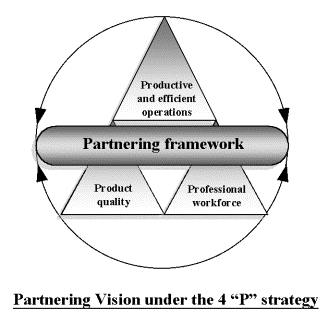Chapter 3 : Vision for Change
3.1 In mapping out the direction for reforms, it is important to identify the core problems involved, set the vision for change and develop reform strategies. Having analyzed the problems identified in the previous chapter, we have drawn up a 4-pronged strategy aimed primarily at enhancing public housing quality, but which we sincerely hope will also engender a wider industry reform.
Lessons from Problems
3.2 The perceived problems from different stakeholders and the community can be summarized as follows -
| (a) | Heavy
workload and fluctuating production arising from previously uneven
land supply |
|
| (b) | Lack of a
common drive to deliver quality housing, with time and cost
considerations often preceding quality |
|
| (c) | Confusion of
roles and responsibilities amongst stakeholders on project
implementation and quality supervision |
|
| (d) | Fragmented
production process which hinders product improvement and process
re-engineering |
|
| (e) | Lack of
partnering and mutual trust between developers and contractors |
|
| (f) | Primitive
industry structure which is labour-intensive and characterized by
multi-layered sub-contracting |
|
| (g) | Inadequate
level of training and employment stability amongst construction
workers |
|
| (h) | Little
investment in research and product development |
|
| (i) | The HD's
overly rigid systems and cumbersome practices |
|
| (j) | Inadequate
project supervision |
|
| (k) | Insufficient commitment to social goals, including site safety, the environment and construction costs |
Our Vision
3.3 The above problems are all inter-related. To tackle them effectively, we need to set out our vision for reform clearly. In our view, the vision for the construction industry in the new millennium should be -
| "To provide quality housing together with all stakeholders through partnering and sustained improvement such that the community can take pride in our housing construction" |
3.4 Quality construction should not be judged solely by the final product. It should also be reflected in the production process. All stakeholders should have a sense of commitment and common purpose in striving to achieve this vision. Thus in order to realize this vision, we intend to adopt a 4 "P" strategy which focuses on -
| (a) | Partnering
: Building up a partnering framework amongst all stakeholders |
|
| (b) | Product
quality : Assuring product quality |
|
| (c) | Professionalism
: Investing in a professional workforce |
|
| (d) | Productivity : Striving for productivity and efficiency |

In subsequent chapters, we will demonstrate how our vision for quality housing can be achieved through the 4 "P" strategy.